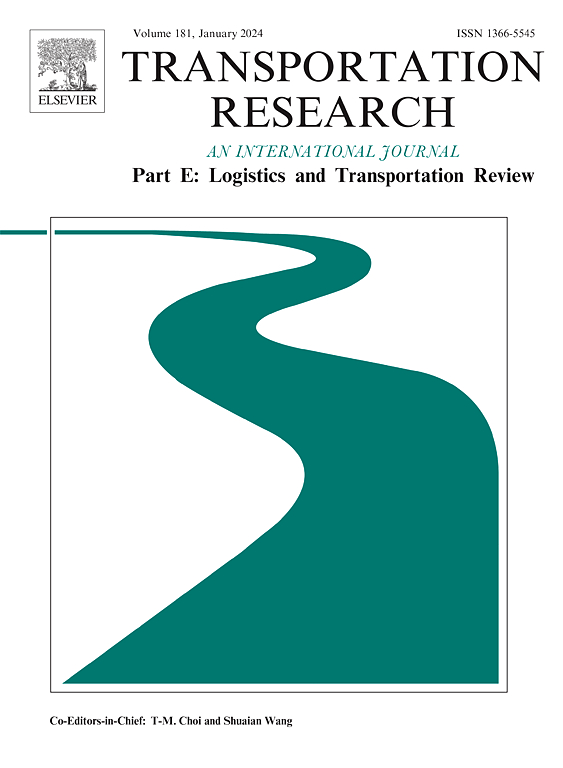电动汽车与汽油汽车混合交通充电站位置优化:随机用户均衡方法
IF 8.8
1区 工程技术
Q1 ECONOMICS
Transportation Research Part E-Logistics and Transportation Review
Pub Date : 2025-09-30
DOI:10.1016/j.tre.2025.104438
引用次数: 0
摘要
充电站(CS)选址规划对于满足电动汽车(ev)日益增长的需求至关重要。针对电动汽车和汽油汽车混合交通路网中充电站的选址和容量问题,提出了一种混合整数非线性规划(MINLP)模型,以实现充电站投资成本和行驶时间成本的最小化。本研究的主要贡献包括:1)现有研究通常假设用户是完全理性的,在用户均衡框架下合作选择最短路径,忽略了感知误差和路径选择的随机性。因此,该模型采用随机用户均衡(SUE)框架来反映混合交通网络中用户感知的不完美性和决策的可变性。ii)在充电站选址规划过程中,往往忽略了不准确的等待时间估计,导致充电站选址不理想且成本高昂。因此,本研究将电动汽车等待时间纳入到位置决策中,并提出了一种基于机器学习的估计模型,以提高预测精度。此外,本研究通过理论推导证明了SUE模式的唯一性,为联合应用麻雀搜索算法、基于路径的逐次平均法和随机森林模型求解MINLP提供了便利。对不同规模的网络进行了案例研究。从一个现实的马萨诸塞州东部公路网的结果表明,等待时间预测的准确性将影响CS的位置-容量结果。与基于用户感知误差和偏好异质性的充电站选址模型相比,基于用户感知误差和偏好异质性的充电站选址模型在最短路径上产生了更分散的交通流和更少的拥堵,从而使出行时间成本降低49.08%,系统总成本降低48.83%。该研究通过解决用户感知误差和实时等待时间预测,为EV CS规划提供了实用价值。未来的研究将考虑动态交通需求和电网相互作用。本文章由计算机程序翻译,如有差异,请以英文原文为准。
Optimizing charging station locations for mixed traffic of electric and gasoline vehicles: a stochastic user equilibrium approach
Charging station (CS) location planning is critical for accommodating the growing demand of electric vehicles (EVs). This paper develops a mixed-integer nonlinear programming (MINLP) model to address the charging station location and capacity problem in the road networks with mixed traffic of electric and gasoline vehicles, aiming to minimize both charging station investment costs and travel time costs. The main contributions of this study include: i) existing studies often assume that users are perfectly rational and cooperatively choose the shortest paths under the user equilibrium framework, overlooking perception errors and the stochastic nature of route choice. Thus, this model adopts a Stochastic User Equilibrium (SUE) framework to reflect users’ imperfect perceptions and decision-making variability in mixed traffic networks. ii) Inaccurate waiting time estimates are often overlooked during charging station location planning, leading to suboptimal and costly locations. Therefore, this study incorporates EV waiting time into the location decision and proposes a machine learning-based estimation model to improve prediction accuracy. Furthermore, this study proves the uniqueness of the SUE pattern through theoretical derivation, facilitating the joint application of the sparrow search algorithm, path-based method of successive averages, and random forest model to solve the MINLP. A case study is conducted on networks of varying sizes. Results from a realistic Eastern-Massachusetts highway network demonstrate that the accuracy of waiting time predictions will impact CS location-capacity results. Compared to the UE-based charging station location model, the SUE-based model produces a more dispersed traffic flow and less congestion on the shortest routes by integrating user perception errors and preference heterogeneity, thereby reducing travel time cost by 49.08% and total system cost by 48.83%. This study provides practical value for EV CS planning by addressing user perception errors and real-time waiting time prediction. Future research includes considering dynamic traffic demand and power grid interactions.
求助全文
通过发布文献求助,成功后即可免费获取论文全文。
去求助
来源期刊
CiteScore
16.20
自引率
16.00%
发文量
285
审稿时长
62 days
期刊介绍:
Transportation Research Part E: Logistics and Transportation Review is a reputable journal that publishes high-quality articles covering a wide range of topics in the field of logistics and transportation research. The journal welcomes submissions on various subjects, including transport economics, transport infrastructure and investment appraisal, evaluation of public policies related to transportation, empirical and analytical studies of logistics management practices and performance, logistics and operations models, and logistics and supply chain management.
Part E aims to provide informative and well-researched articles that contribute to the understanding and advancement of the field. The content of the journal is complementary to other prestigious journals in transportation research, such as Transportation Research Part A: Policy and Practice, Part B: Methodological, Part C: Emerging Technologies, Part D: Transport and Environment, and Part F: Traffic Psychology and Behaviour. Together, these journals form a comprehensive and cohesive reference for current research in transportation science.

 求助内容:
求助内容: 应助结果提醒方式:
应助结果提醒方式:


